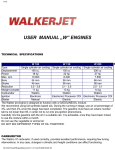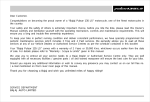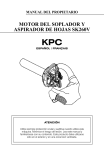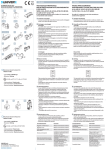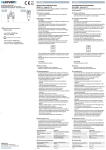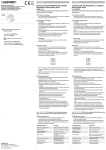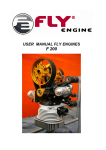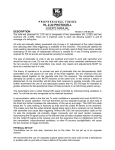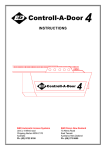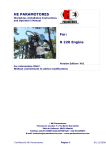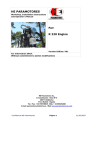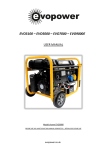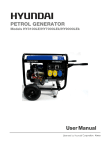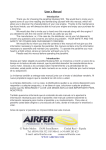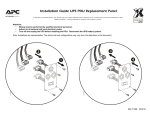Download WALKERJET RR 200 Eng
Transcript
Table of Contents 1 IMPORTANT NOTICES ...................................................... 3 2 INSTRUCTIONS FOR USE .................................................. 4 3 SUPPLEMENTS ............................................................... 4 3.1 SUPPLEMENTING THE MANUAL - CHANGES 4 3.2 POWERED PARAGLIDER DATA SHEET 5 4 CONTROL ELEMENTS ...................................................... 6 4.1 FLIGHT CONTROLS 6 4.2 THROTLE CONTROL 6 4.3 IGNITION ON and OFF SWITCH 6 4.4 STARTER BUTTON 6 4.5 MASTER STARTER SWITCH 6 5. AIRCRAFT BASIC TECHNICAL DATA .................................. 6 6. PARAMOTOR SPECIFICATIONS ........................................ 7 7. EMERGENCY RESCUE PARACHUTE ................................. 7 7 PARAMOTOR PARTS AND EQUIPMENT................................ 7 7.1 ENGINE 7 7.2 PROPELLER 8 8 OPERATIONAL RESTRICTIONS .......................................... 8 8.1 SPEED RANGE 8 8.2 OPERATIONAL RESTRICTIONS DUE TO WIND SPEED 8 8.3 POWER UNIT RESTRICTIONS 8 8.4 LOAD WEIGHT RESTRICTIONS 8 8.5 POWER OUTPUT (model dependant) 8 8.6 OPERATIONAL G-LOAD FACTORS 9 8.7 OTHER OPERATIONAL RESTRICTIONS 9 9 EMERGENCY PROCEDURES.............................................. 9 9.1 ENGINE FAILURE (BELOW ALTITUDE OF 200 M) 9 9.2 ENGINE FAILURE (ABOVE THE ALTITUDE OF 200 m) 9 9.3 FIRE 9 9.4 VIBRATIONS 9 9.5 USE OF EMERGENCY SYSTEM 10 10 COMMON PROCEDURES ................................................10 10.1 TORQUE VALUES: 10 10.2 FLIGHT POSITION ADJUSTMENT OF THE SEAT 10 11 PRE-FLIGHT PREPARATION ............................................10 11.1 ASSEMBLY OF CAGE AND FRAME 10 11.2 PRE-FLIGHT INSPECTION 11 11.3 ENGINE CHECK 11 11.4 FILLING UP WITH FUEL 12 11.5 START 12 11.6 LAUNCH 12 11.7 ABORTING TAKE OFF 13 11.8 FLIGHT 13 11.9 FLIGHT IN TURBULENCE 13 11.10 TURNS 14 12 LANDING ....................................................................14 13 PACKING THE CANOPY..................................................14 14 ADJUSTMENT AND MAINTENANCE OF THE ENGINE ............14 14.1 BREAK-IN OF THE ENGINE 14 15 FUEL AND OIL ..............................................................14 15.1 CARBURATOR SETTING 15 16 REDUCTION BELT TIGHTENING .......................................15 17 PROPELLER ................................................................15 18 REGULAR MAINTENANCE ..............................................16 19 TROUBLESHOOTING .....................................................16 20 PARAMOTOR TRANSPORT .............................................17 20.1 ASSEMBLED 17 20.2 DISASSEMBLED 17 21 STORAGE ...................................................................17 21.1 SHORT TERM 17 21.2 LONG TERM - WINTER STORAGE 17 22 ILUSTRATIONS................................................................ 23 GLIDER HOOK UP ADJUSTMENT ......................................... 24 ENGINE PARTS DIAGRAM .................................................. 25 ELECTRICAL WIRING ........................................................ WARRANTY AND SERVICE MANUAL ....................................18 1 INTRODUCTION .............................................................18 2 START OF THE WARRANTY ..............................................18 2.1 WARRANTY CONDITIONS 18 2.2 WARRANTY REPAIRS PROCEDURE 19 2 2.3 WARRANTY TRANFER 19 2.4 APPLICATION OF WARRANTY 19 3. PRESCRIBED REPLACEMENT OF INDIVIDUAL PARTS ...........19 4. OBLIGATORY SERVICE EXAMINATIONS .............................20 5 SERVICE RECORDS ........................................................21 6 NOTES: .......................................................................22 1 IMPORTANT NOTICES • Observe the regulations of ultra-light aircraft operation. • Don’t overestimate your piloting abilities. Use suitable area s for landing and take offs and practice emergency landings. • Watch for weather forecasts. Don’t set out for longer flights, if storms, fog, or showers are to occur. • Observe the fuel content • When choosing the flight direction and altitude, you must always take into account the possibility of an emergency landing. • Do not perform acrobatic manoeuvres. • Don’t underestimate navigation. Don’t fly cross-country without becoming familiar with the navigation and without proper requisites (map, compass, GPS). • Set out for flight only when you are physically and mentally prepared. 3 2 INSTRUCTIONS FOR USE 1) The powered paraglider manufacturer issues this manual. Pilot is recommended to have the manual with him/her when flying. 2) Records must be readable and no pages may be torn out. 3) Manual is a part of technical documentation together with new supplements. 4) Total number of flight hours and takeoffs + landings must be recorded in a logbook. 5) WJ paramotor dealer (inspector-technician) must be informed of any substation damage to the paramotor! The dealer (inspector-technician) or the manufacturer will recommend the method of repair, will supervise the repair and will carry out technical check once repair is completed. A record must be made in the Service Records part of the manual. 6) Any completed major repairs must be inspected and approved by Walkerjet paramotor dealer (inspector-technician) 7) The powered paraglider owner is responsible for of validity operational records. 8) The Walkerjet paramotor dealer must approve all construction changes to a Powered Paraglider. (Inspector-technician) The owner, operator and the pilot of this powered paraglider must become familiar with this operating manual. 3 SUPPLEMENTS 3.1 SUPPLEMENTING THE MANUAL - CHANGES If there are any changes concerning the regulations or the PPG construction, a bulletin of such changes will be sent or published on the Internet at www.walkerjet.cz web sites. Every owner is obliged to carry out such changes and to make record of these changes in this manual. 4 Other data Place and date of production Czech Republic RR MODEL Production number Walkerjet Paramotor Manufacturer Canopy Czech Republic W 200 Walkerjet Engine Czech Republic 1:3 1:3 Reduction POWERED PARAGLIDER DATA SHEET 130 cm Germany HELIX Propeller Emergency system 3.2 POWERED PARAGLIDER DATA SHEET 5 4 CONTROL ELEMENTS 4.1 FLIGHT CONTROLS Powered Paraglider turns to the left by pulling left steering toggle down. Powered Paraglider turns to the right by pulling right steering toggle down. Pulling both steering toggles simultaneously increases angle of attack, gliding ratio and decreases speed – be aware of stall (see the paraglider manufacturer's manual). 4.2 THROTLE CONTROL Right hand. Pushing the trigger increases RPM of the engine and vice versa. 4.3 IGNITION ON and OFF SWITCH Right hand thumb. By switching the red button to the stop position, you will stop the engine. 4.4 STARTER BUTTON Right hand index finger. By pressing and holding the button, you will start the engine. (Engines with electric starter only) 4.5 MASTER STARTER SWITCH Right side. Switch placed on the bottom part of the frame. The switch disengages starter motor. 4.6 EMERGENCY RESCUE SYSTEM Spare parachute - In front, between the comfort bars – if applicable. 4.7 SECONDARY IGNOTION SWITCH Right hand thumb. Will switch ignition off if main ignition switch malfunctions. 4.8 CRUISE CONTROL Right hand thumb. To engage push cruise button in until you hear click – this signifies cruise control set. To cancel, apply full power gradually until cruise button releases. 4.8 PARAGLIDER TORQUE CONTROL TRIM Left D riser - left hand. To apply (pull down) during flight at 50% or more power to eliminate engine torque turn. Push cam buckle to release trim before landing or during thermal flights. 5. AIRCRAFT BASIC TECHNICAL DATA Minimum flight weight (kg) Maximum flight weight (kg Fuel tank (litres) 60 kg 150 kg 13 L 6 6. PARAMOTOR SPECIFICATIONS MODELS ENGINE HORSE POWER REDUCTION PROPELLER WEIGHT CARBURATOR GAS TANK CAGE PARTS RR W 200 25 HP 3:1 130 / 120 cm 28 / 26 kg Wallbro 37 13 l 3 NOTE: Weight - paramotor without fuel. 7. EMERGENCY RESCUE PARACHUTE Manufacturer Model Serial number Way of activation Descent Rate (m/s) Maximum weight 7 PARAMOTOR PARTS AND EQUIPMENT 7.1 ENGINE Type W 200 Carburettor WB 37 WALBRO WB-32 Cylinder volume 200 CC Dry engine weight 10 kg Engine and accessories weight 14 kg Fuel Unleaded gas 94 or 95 Mean consumption 4 litre per hour Oil Synthetic Mixing ratio 40:1 Ignition Electronic Engine reduction 3:1 NOTE: W 200 engine is not certified as aircraft engine, a failure can occur anytime! 7 7.2 PROPELLER Diameter Material Weight 1500 g Number of blades 3 130 Model RR Carbon 120 Model RR Carbon Pitch 8 1400 g 3 11 8 OPERATIONAL RESTRICTIONS 8.1 SPEED RANGE Speed range is given by the speed range of the paraglider. 8.2 OPERATIONAL RESTRICTIONS DUE TO WIND SPEED According to the paraglider. In general it is not recommended to fly in winds exceeding 25 km/h. It is not advisable to take off and/or to land with ANY tail wind. 8.3 POWER UNIT RESTRICTIONS Maximum RPM (7 min max) Maximum cruise RP Idle Max Operational Temperature 7 500 RPM 6 000 RPM 1 800 RPM 250 oC 8.4 LOAD WEIGHT RESTRICTIONS Minimum pilot weight Maximum pilot weight Maximum take-off weight Empty apparatus weight 60 kg 160 kg 150 kg 28 kg 8.5 POWER OUTPUT (model dependant) Static thrust (propeller 110, 130) 85 kg Mean climbing capacity 3 m/s Ceiling 4000 m Max Flight duration 3 hrs Range approximately 150 km 8 8.6 OPERATIONAL G-LOAD FACTORS Maximum positive G-load factor in the centre of gravity - 1,0 Maximum negative G-load factor in the centre of gravity - 2,0 8.7 OTHER OPERATIONAL RESTRICTIONS The paramotor can be operated in the temperature range of 0 °C +40 °C. The frequency of paraglider canopy examinations is determined by the paraglider manufacturer. The paraglider manufacturer must determine the load-bearing lines examination frequency and possible replacement. If the manufacturer doesn't state otherwise, it is recommended to contact the manufacturer after 50 - 70 flight hours and to arrange the load-bearing lines examination because the lines strength may have worsened. ONLY VISUAL FLIGHT RULE FLIGHTS (WHEN THE GROUND IS VISIBLE) ARE PERMITTED! 9 EMERGENCY PROCEDURES 9.1 ENGINE FAILURE (BELOW THE ALTITUDE OF 200 m) - Choose suitable emergency landing area and land. 9.2 ENGINE FAILURE (ABOVE THE ALTITUDE OF 200 m) - Check the fuel level If fuel is present try to regenerate the fuel supply by squeezing primer bulb Try to re-start the engine If engine cannot be re-started choose suitable emergency landing area and land. 9.3 FIRE - Switch off the ignition Land immediately. 9.4 VIBRATIONS If unnatural vibrations occur: 9 - Adjust the engine revolutions in such mode in which the vibrations are the smallest Proceed to landing If the vibrations are getting worse, immediately switch of the motor and prepare for emergency landing 9.5 USE OF EMERGENCY SYSTEM Spare parachute - If applicable. If the paraglider is definitely out of control such as uncontrollable spin or any other major flight failure, switch off the ignition, grasp the emergency parachute handle by your hand, and throw it to the left and behind or in the direction of the spin. 10 COMMON PROCEDURES Each paramotor has been tested in operation. All connecting elements have been examined carefully before the delivery. It is important to check and retighten all nuts of cylinder head and exhaust pipe after 2 hours of operation when the nuts are finally properly seated due to heat and vibration. The use of torque rench is absolutely necessary. 10.1 TORQUE VALUES Cylinder head 9 Nm Prop 15 Nm Spark plug 20 Nm All other M8 bolts 20 Nm All other M6 bolts 10 Nm 10.2 FLIGHT POSITION ADJUSTMENT OF THE SEAT Flight position adjustment of your seat must be carried out before the first flight. It is necessary to adjust the leg and shoulder strap lengths. Sitting position during flight is comfortable when slightly tilted backwards. It is recommended to suspend the assembled paramotor to simulate the flight position and to try the transition from sitting position to the suspended position used for landing. The above-mentioned procedure will ensure an easy take-off, comfortable flight and safe landing. In the flight position the angle between the propeller and vertical axis must be approximately 2º. Every pilot must adjust the flight position for his/her height and weight. 11 PRE-FLIGHT PREPARATION 11.1 ASSEMBLY OF CAGE AND FRAME Mount the left and right side of the cage. The bottom connection must be connected first – insert all the way. Connect top connector. If you have difficulties to assemble due to the tight fit, position your self by the prop side of paramotor. Place one hand on frame and the other on the cage section. Use your thumb to guide the male and female connector together. Slide the top section(s) of the cage on the four connectors. Connect the outside sides of the top frame to the side frames 2 connectors. Attach comfort bars and harness shoulder buckles to the top of the frame. Secure all 12 frame connections by Velcro straps. (6 on each side) 10 PROPELLER – attach the propeller to the reduction so as the central hole sits close to the delimination ring, attach the propeller flange and secure it by four screws and manually tighten them by torque wrench in the order 1-4-2-5-3-6. See torque values above. Be careful not to damage the propeller hub by excessive tightening. It is recommended to turn the propeller manually once to make sure the propeller is attached correctly and clears all parts of the cage. Administrate pre-flight check of your assembled paramotor - visual control of all the bolts, houses, connections etc. is necessary. Administrate pre-flight check of your glider Attach paraglider - make sure to screw the pins on Maillon shackles all the way. Secure the secondary straps from harness to the glider’s risers creating two independent connections. Attach speed system. Re-check attchment of rescue parachute. Double-check everything. 11.2 PRE-FLIGHT INSPECTION The pilot must carry out pre-flight examination before every flight to check the technical condition of paramotor and to ensure maximum safety and pleasurable flight. Examined part Frame Nylon Strings Propeller Motor Reduction Gear Other parts Gas Tank Harness Emergency reserve Oil Gasoline Motor test Pilot Instruments Paraglider Exhaust Examination Integrity, assembly Integrity, tightness Orientation, tightened screws, integrity Silent blocks, carburettor bolts, exhaust bolts, Engine bolts Screws, belt tightness Overall condition, gasoline supply, electric contacts, switches, spark plug cable Tightness of fuel hoses and tank closure, tightness of bolts Buckles, frame attachments Attachment, pin, handle Right mixture Sufficient amount of fuel for flight – fresh mixture High Revolutions, idle run, switch-off Helmet, shoes, warm clothes, gloves, Variometer, GPS, pocket radio or cell phone Canopy condition, lines Tightness, integrity 11.3 ENGINE CHECK After finishing the overall pre-flight inspection, you can proceed to the engine check. Remove all objects and loose items near the engine to prevent them from being drawn in by the propeller (pay attention to loose parts of your clothes). 11 11.4 FILLING UP WITH FUEL - Only fill the gas tank when the engine is off - Fill the tank through a filtration insert and, in the course of filling, check the purity of fuel - Do not smoke while filling up - Use certified gas tanks only - Use only funnel approved for gasoline - Do not wear clothing that may produce static electricity 11.5 START Before starting a cold engine, it is necessary to prime the carburettor. Tilt machine 45 degrees to the carburettor side. The carburettor is equipped with a vent at the bottom; plug this vent with your index finger while squeezing the primer bulb. Squeeze the primer pump several times until the fuel drips out of the air filter and remove your index finger. Wait until most fuel drips out. Tilt paramotor back. WARNING: NEVER ATTMPT TO START THE ENGINE WITHOUT THE PROPELLER!!! DO NOT STAND IN DANGEROUS PROXIMITY TO THE ENGINE, ESPECIALLY IN FRONT OR ALONG THE SIDE OF THE PROPELLER. Manual start: Grasp the recoil starter handle, place your foot on the bottom part of the paramotor stand hold the paramotor frame with left hand and start the engine by pulling the cord. Electric start: place your left foot on the bottom part of the paramotor stand hold the paramotor frame with left hand and start the engine by pushing the start button. After the engine starts running, warm it up in low and medium revolutions for 2 minutes until it starts to run smoothly. After then engine is running smoothly, switch it off and hook in your paraglider. 11.6 LAUNCH Always launch into the wind, making sure that your path is clear of obstructions. Pay special attention to power lines. Your take-off stance is the same as in regular paragliding. Hold the accelerator handle in your right hand (putting it on over the steering toggle). The A risers must be held at the link level (in their upper part) wedged between the thumb and lower part of index finger. Stretch your arms into medium position, with elbows slightly bent, and check your position relative to the paraglider making sure you are exactly in its centre axis in order to ensure symmetrical 12 canopy inflation. To check your position proceed slightly forwards until the A lines are stretched, your position is correct when you feel an equal pressure on both sides. Make sure, at the same time, that you don't turn, otherwise you could hit your helper by the engine or catch a paraglider line. The canopy inflation is done with the accelerator in idle position. Before you begin raising your hands, lean against the front straps. Watch the paraglider rising, checking it visually without stopping. When the glider is above your head, release the risers and gradually apply full throttle. Make sure that you continue to run, while taking longer and longer strides, with your back upright, until you are lifted off the ground. To reduce the speed with which you have to run to attain lift-off speed of the glider, you may pull the brake toggles down according to the current wind speed and direction. This will generate more lift and aid your take off. For safety reasons, it is advisable to attain at least 10 meters of altitude, before trying let go of brake toggles or to drop speed system footrest. Should the engine quit while you are taking off, quickly apply brakes (flare) and run out the take-off attempt. Reverse inflation: For reverse inflation, grasp the brakes - they should be on top of the webbing risers. (The right one with your right hand and the left one with your left hand) Your left hand should grab the front lines (A) of the right side of paraglider (the way you face it) and your right hand should grab the front lines (A) of the left side of paraglider. Perform reverse inflation and turn 180 degrees clockwise. Make sure the paraglider is inflated; you face into the wind direction start applying power. On a windy day you will be airborne within a few steps. On low wind day it may take as many as 10 steps and you will have to apply full power and approximately half brakes to get airborne. To reduce the speed with which you have to run to attain lift-off speed of the glider, you may pull the brake toggles down according to the current wind speed and direction. This will generate more lift and aid your take off. For safety reasons, it is advisable to attain at least 10 meters of altitude, before trying let go of brake toggles or to drop speed system footrest. Should the engine quit while you are taking off, quickly apply brakes (flare) and run out the take-off attempt. 11.7 ABORTING TAKE OFF Abort take-off if the following occurs: - Paraglider suffers asymmetric collapse - Paraglider leading edge folds up (frontal collapse) - Paraglider is not properly inflated - Engine cannot achieve max. RPM - Other unanticipated problems 11.8 FLIGHT See the paraglider-operating manual 11.9 FLIGHT IN TURBULENCE See the paraglider manual 13 11.10 TURNS See the paraglider manual 12 LANDING Watch the landing zone carefully, check for obstructions and direction of the wind. Always land against into the wind. Press the OFF switch and hold it until the engine stops at the altitude of at least 30m over the ground. At 10 meters above ground, sit out of your harness and extend your legs with one foot forward, ready to run. Flare 1 m over ground. Turn 180 degrees and collapse the paraglider in such a way as to prevent the contact of the canopy and lines with warm parts of the engine. 13 PACKING THE CANOPY • After landing fasten the toggles to the risers by means of magnet snaps. Unfasten the canopy from the paramotor. • First arrange the rear lines, than the front ones. When you proceed this way, you will see that next time the lines will not be tangled. Insert risers to two different cells. • Roll the canopy from the ears toward the centre so that the overall width of folded canopy is approximately equal to the width of the pack. • Push the air from all channels. Fold the wing to make it fit in the pack. 14 ADJUSTMENT AND MAINTENANCE OF THE ENGINE 14.1 BREAK-IN OF THE ENGINE Proper break-in of the engine is very important because of two reasons: 1) Check of regular function in all RPM modes 2) Proper warm-up of the engine and subsequent settling of all its parts It is recommended to let the engine run on the ground in medium revolutions for 1 hour at first and to accelerate from time to time to the full output for 1-2 sec, and then to slow to medium revolutions again. Towards the end of this testing hour, let the engine run at full revolutions for about 1 minute. It is important to keep the mix ratio according to the table below. The engine will be ready for the first flight after this procedure. It is recommended not to run the engine at the full output for a long time during the first flight 5 hours - use the full output for take off only (max 1 minute) and change the RPM during the flight itself often. After 5 hrs of flight time, the engine is ready for non-restricted use. 15 FUEL AND OIL The engine manufacturer and the company WALKERJET recommend using 100 % synthetic oil in the proper mix ratio toalow for proper lubrication and to prevent carbonising of combustion and exhaust chambers. See table below. It is recommended not to store the fuel mixture for longer than several days; the maximum storage time is 2-3 weeks. If the fuel mixture is stored for longer time, the oil can get debased and there is a risk of engine seize-up. 14 MODE Break-in Regular operation TIME 10 hours 10 and more hours RATIO 1: 30 1: 40 Use exclusively leaded or unleaded gasoline with octane number 94 or 95 ANY MECHANICAL DEFECTS LEADING TO ENGINE SEIZE-UP ARE NOT SUBJECT TO WARRANTY REPAIR. THESE DEFECTS ARE ALWAYS CAUSED BY NON-OBSERVANCE OF THE RUNNING-IN REGULATIONS, USING NON-QUALITY FUEL OR OIL, USING WRONG MIX RATIO, OR BY ANY COMBINATION OF THESE FACTORS. 15.1 CARBURATOR SETTING Setting is done by turning the HI or LO screws counterclockwise from the tightened (fully closed) position of the screw. Be careful not to be too aggressive when turning HI or LO screw clockwise looking for closed position as excessive torque could damage needle seat inside carburettor. MODEL RR "L" screw "H" screw Standard 3/4 turn 1 1/4 turn 16 REDUCTION BELT TIGHTENING Amount of the belt stretch between small and large pulley should range between 5 - 2 mm. If you want to tighten the belt, loose the box nut, set the right tightness of the belt by turning the eccentric shaft, then tighten the box nut to a stop. 17 PROPELLER - Always store the propeller in a dry place - Don’t expose the propeller to extreme temperature changes - Store the propeller in horizontal position - Don’t expose the propeller to sunshine without purpose - Check the propeller after each flight. Any small nicks must be treated to prevent moisture penetration. You can carry out minor repairs, using appropriate procedure. After the repair is finished, you must balance the propeller. Please, pay attention to the fact that any propeller repair carried out by the customer is not subject to the warranty. - Propeller should be balanced professionally after every 50 hrs of operation or if you notice increased vibrations. - Any adjustments or repairs carried out to the propeller by an unauthorized person can lead to serious consequence including but not limited to strong vibrations, propeller breakage and loss during flight, frame damage, reduction drive damage, other parts damage). 15 18 REGULAR MAINTENANCE See the warranty and service book. 19 TROUBLESHOOTING DEFECT INDICATION Flooded The engine doesn't engine start, the ignition doesn't operate It is possible to smell fuel The engine still doesn't start The engine still doesn't start Engine The engine four-cycles runs in low revolutions (irrerough gular run) The engine four-cycles in high revolutions Incorrect The carburettor is adignition justed correctly, but the engine doesn't start well and the engine runs rough Contami- The engine doesn't nated air draw filter Engine Prop will not turn 360 does not when starting button crank pressed over Loose The belt slips and reduction whistles belt Increasing vibrations Damaged propeller Vibrating The propeller is not dapropeller maged but still causes vibrations SOLUTION Manually turn the propeller 3 times against the direction of turning Crank the engine over 5 times manually or by electric starter Pull out and dry the plug, turn the propeller 3 times in the direction of turning Tune up by carburettor "L" screw (see carburettor adjustment) Tune up by carburettor "H" screw (see carburettor adjustment) Ignition plug - check up contacts and clearance, adjust the distance of magnet contacts (0.25). The engine must have min. 600 RPM after it is started up. Remove the air filter, blow it through, clean it up Make sure prop is mounted. Motor will not crank over without prop mounted! Charge batteries. Possible battery replacement needed. Tighten the belt (see Reduction belt tightening) In case of extensive damage, have the propeller replaced. In case of minor damage, have the propeller repaired by an authorized person. Static balancing of the propeller 16 20 PARAMOTOR TRANSPORT 20.1 ASSEMBLED - Close the gas tank with transport cap - Secure the paramotor against fall or damage 20.2 DISASSEMBLED - Drain fuel from gas tank - Close the tank by transport cap - Disconnect the seat, disassemble the prop (if needed) cage and comfort bars - It is recommended to use transport bag for protection 21 STORAGE 21.1 SHORT TERM - Drain fuel from gas tank - Close the tank by transport cap - Turn the prop to horizontal position 21.2 LONG TERM - WINTER STORAGE - Drain most of the fuel from gas tank - Start the motor and run until at idle until it runs out of fuel - Drain the remaining fuel from gas tank - Turn the propeller to horizontal position or dismantle - Store the paramotor in a dry and clean place with constant temperature - Paramotor should be plugged in if possible during storage so the battery is fully charged all the time. If you can’t have it plugged in make sure that you charge your battery periodically - once a month even if the paramotor is not being used. This will improve the life span of the battery. 17 WARRANTY AND SERVICE MANUAL 1 INTRODUCTION Thank you for purchasing WALKERJET paramotor. We believe that WALKERJET paramotor will satisfy your expectations and provide you with many years of flying. WALKERJET company is acknowledged worldwide as a manufacturer of quality paramotors, and with your new paramotor you will get more than simply the benefit of technical success and experience gained from more than 10 years of innovation and PPG manufacturing. It is necessary to read User Manual delivered together with your paramotor. This WARRANTY AND SERVICE MANUAL contains details concerning the warranty and regular service examinations, which are necessary to maintain your paramotor performance during its service life. Service work carried out by our workshop will be recorded in the service records. Always produce this book whenever you visit any WALKERJET workshop or dealer for the purpose of repair, order of parts or accessories. 2 START OF THE WARRANTY WALKERJET support starts on the day when paramotor is handed over to the end user unless otherwise stated. Each new paramotor is subject to 12 months warranty. Any defect arising during 12 months after the hand-over date as a consequence of workmanship or defective material will be repaired free of charge by the dealer you have purchased the paramotor from. WALKERJET will consider a claim for a warranty repair after the regular 12 months warranty period in extraordinary conditions. 2.1 WARRANTY CONDITIONS Service examinations to your paramotor must be carried out according to the service examination plan for individual models of WALKERJET paramotors and must be carried out exclusively by an authorized WALKERJET dealer. Your paramotor must not be neglected, improperly used or modified. The maximum load stated in the manual mustn't be exceeded. 18 All Walkerjet paramotors and SKY Paragliders carry a 12 month manufacturer warranty for manufacturing defects ONLY. Items NOT covered under this warranty may include: • • • • • • Improper storage of paramotor and/or paraglider Improper break in of paramotor resulting in engine seizure Not following operating instructions as outlined in PPG course and or in Walkerjet paramotor manual Improper maintenance of paramotor and/or paraglider Damage resulting from PPG accident Damage resulting from normal wear and tear 2.2 WARRANTY REPAIRS PROCEDURE Transport the complete unit to WALKERJET (authorized manufacturer) or authorized dealer which will carry out the repair free of charge providing all warranty conditions have been followed and the warranty repair has been judged as justifiable. 2.3 WARRANTY TRANFER If you sell the paramotor during the warranty period, the balance of the warranty is automatically transferred to the next owner. 2.4 APPLICATION OF WARRANTY 1. Please, read the operational manual carefully. 2. Carry out regular checks. 3. Always have your paramotor serviced in accordance with the service examination plan published in this manual and have the service work recorded in appropriate place in the service book. 4. Always have the service book with you at all regular and other service checks. The service book is your paramotor history record and the manufacturer or authorized WALKWERJET dealer will request it before starting any warranty repair or other services. 19 3. PRESCRIBED REPLACEMENT OF INDIVIDUAL PARTS PARAMOTOR'S AGE 1 2 3 4 5 6 7 8 NUMBER OF FLOWN HOURS 50 100 150 200 250 300 350 400 Primer Bulb Reduction bearings • • • • • • • • • • • • Reduction shaft • • Engine bearings Frame connection pins • • • • Bolt re-tightening • • • • Silent blocks Main suspensions • • • • • • • • Nylon strings 4. OBLIGATORY SERVICE EXAMINATIONS PARAMOTOR'S AGE NUMBER OF FLOWN HOURS OBLIGATORY SERVICE EXAMINATION 10 30 1 50 • • • • • • • • • • • • • • • • • • • • PROP BALANCING PROP BALANCE CHECK • • 2 100 3 150 4 200 5 250 6 300 20 5 SERVICE RECORDS NUMBER OF FLOWN HOURS OBLIGATORY EXAMINATION DATE NUMBER OF FLOWN HOURS ADDITIONAL EXAM- OBLIGATORY EXINATION AMINATION DATE NUMBER OF FLOWN HOURS OBLIGATORY EXAMINATION DATE NUMBER OF FLOWN HOURS ADDITIONAL EXAM- OBLIGATORY EXINATION AMINATION DATE NUMBER OF FLOWN HOURS OBLIGATORY EXAMINATION DATE DATE NUMBER OF FLOWN HOURS ADDITIONAL EXAM- OBLIGATORY EXINATION AMINATION ADDITIONAL EXAMINATION ADDITIONAL EXAMINATION ADDITIONAL EXAMINATION 21 SERVICE RECORDS NUMBER OF FLOWN HOURS OBLIGATORY EXAMINATION DATE NUMBER OF FLOWN HOURS ADDITIONAL EXAM- OBLIGATORY EXINATION AMINATION DATE NUMBER OF FLOWN HOURS OBLIGATORY EXAMINATION DATE NUMBER OF FLOWN HOURS ADDITIONAL EXAM- OBLIGATORY EXINATION AMINATION DATE NUMBER OF FLOWN HOURS OBLIGATORY EXAMINATION DATE DATE NUMBER OF FLOWN HOURS ADDITIONAL EXAM- OBLIGATORY EXINATION AMINATION ADDITIONAL EXAMINATION ADDITIONAL EXAMINATION ADDITIONAL EXAMINATION 22 SERVICE RECORDS NUMBER OF FLOWN HOURS OBLIGATORY EXAMINATION DATE NUMBER OF FLOWN HOURS ADDITIONAL EXAM- OBLIGATORY EXINATION AMINATION DATE NUMBER OF FLOWN HOURS OBLIGATORY EXAMINATION DATE NUMBER OF FLOWN HOURS ADDITIONAL EXAM- OBLIGATORY EXINATION AMINATION DATE NUMBER OF FLOWN HOURS OBLIGATORY EXAMINATION DATE DATE NUMBER OF FLOWN HOURS ADDITIONAL EXAM- OBLIGATORY EXINATION AMINATION ADDITIONAL EXAMINATION ADDITIONAL EXAMINATION ADDITIONAL EXAMINATION 23 SERVICE RECORDS NUMBER OF FLOWN HOURS OBLIGATORY EXAMINATION DATE NUMBER OF FLOWN HOURS ADDITIONAL EXAM- OBLIGATORY EXINATION AMINATION DATE NUMBER OF FLOWN HOURS OBLIGATORY EXAMINATION DATE NUMBER OF FLOWN HOURS ADDITIONAL EXAM- OBLIGATORY EXINATION AMINATION DATE NUMBER OF FLOWN HOURS OBLIGATORY EXAMINATION DATE DATE NUMBER OF FLOWN HOURS ADDITIONAL EXAM- OBLIGATORY EXINATION AMINATION ADDITIONAL EXAMINATION ADDITIONAL EXAMINATION ADDITIONAL EXAMINATION 24 SERVICE RECORDS NUMBER OF FLOWN HOURS OBLIGATORY EXAMINATION DATE NUMBER OF FLOWN HOURS ADDITIONAL EXAM- OBLIGATORY EXINATION AMINATION DATE NUMBER OF FLOWN HOURS OBLIGATORY EXAMINATION DATE NUMBER OF FLOWN HOURS ADDITIONAL EXAM- OBLIGATORY EXINATION AMINATION DATE NUMBER OF FLOWN HOURS OBLIGATORY EXAMINATION DATE DATE NUMBER OF FLOWN HOURS ADDITIONAL EXAM- OBLIGATORY EXINATION AMINATION ADDITIONAL EXAMINATION ADDITIONAL EXAMINATION ADDITIONAL EXAMINATION 25 SERVICE RECORDS NUMBER OF FLOWN HOURS OBLIGATORY EXAMINATION DATE NUMBER OF FLOWN HOURS ADDITIONAL EXAM- OBLIGATORY EXINATION AMINATION DATE NUMBER OF FLOWN HOURS OBLIGATORY EXAMINATION DATE NUMBER OF FLOWN HOURS ADDITIONAL EXAM- OBLIGATORY EXINATION AMINATION DATE NUMBER OF FLOWN HOURS OBLIGATORY EXAMINATION DATE DATE NUMBER OF FLOWN HOURS ADDITIONAL EXAM- OBLIGATORY EXINATION AMINATION ADDITIONAL EXAMINATION ADDITIONAL EXAMINATION ADDITIONAL EXAMINATION 26 6 NOTES: 27 6 NOTES: 28




























